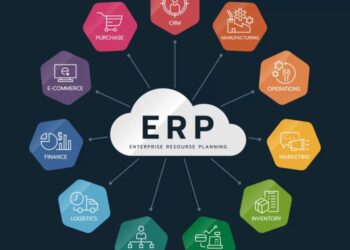Delving into the realm of Oracle and SAP, two giants in the tech industry, opens up a world of innovation and competition. As we navigate through their histories, core products, market presence, and more, a deeper understanding of these powerhouse companies emerges.
From the key features and capabilities to the implementation processes, integration with other systems, industry applications, and cost analysis, this exploration aims to shed light on the nuances of Oracle and SAP.
Overview of Oracle and SAP
Oracle and SAP are two of the largest software companies in the world, known for providing enterprise software solutions to businesses of all sizes.
Brief History
Oracle was founded in 1977 by Larry Ellison, Bob Miner, and Ed Oates. It initially focused on developing a relational database management system (RDBMS) called Oracle Database. Over the years, Oracle expanded its product offerings to include cloud applications and infrastructure, as well as consulting and support services.SAP, on the other hand, was founded in 1972 by five former IBM engineers in Germany.
The company originally developed enterprise resource planning (ERP) software to help businesses streamline their operations. Today, SAP offers a wide range of software solutions, including ERP, customer relationship management (CRM), supply chain management (SCM), and business intelligence (BI) tools.
Core Products and Services
Oracle's core products include Oracle Database, Oracle Cloud Infrastructure, Oracle Fusion Applications, and various industry-specific solutions. The company also provides consulting, support, and training services to help customers maximize the value of their investments in Oracle products.SAP's core products revolve around its ERP software, including SAP S/4HANA, SAP Business One, and SAP Business ByDesign.
The company also offers CRM, SCM, BI, and analytics solutions, as well as cloud-based services through its SAP Cloud Platform.
Market Presence and Popularity
Both Oracle and SAP have a strong presence in the enterprise software market, with a large customer base spanning various industries worldwide. Oracle is known for its robust database technology and cloud offerings, while SAP is recognized for its comprehensive suite of ERP solutions.In terms of popularity, Oracle and SAP are often considered top choices for large enterprises looking to modernize their IT infrastructure and streamline their business processes.
The competition between the two companies is fierce, as they continue to innovate and develop new technologies to meet the evolving needs of their customers.
Oracle vs. SAP
In the realm of enterprise software solutions, Oracle and SAP are two major players with distinct features and capabilities. Let's delve into the key aspects that set them apart.
Oracle’s Software Solutions
Oracle offers a wide range of software solutions tailored for various business needs. Some key features of Oracle's software include:
- Robust Database Management: Oracle is renowned for its powerful database management system, providing scalable and secure storage solutions for organizations of all sizes.
- Enterprise Resource Planning (ERP): Oracle's ERP solutions streamline financial, human resources, and supply chain management processes, enhancing operational efficiency.
- Customer Relationship Management (CRM): Oracle's CRM software helps businesses effectively manage customer interactions and improve customer satisfaction.
- Business Intelligence: Oracle's business intelligence tools enable data-driven decision-making through advanced analytics and reporting capabilities.
SAP’s Software Offerings
SAP is a leader in enterprise software solutions, offering a comprehensive suite of products to meet diverse business requirements. The primary capabilities of SAP's software include:
- Integrated Business Processes: SAP's software solutions seamlessly integrate various business functions, enabling efficient collaboration and workflow automation.
- Cloud Computing: SAP offers cloud-based solutions that provide flexibility, scalability, and cost-effectiveness for businesses transitioning to the cloud.
- Industry-Specific Solutions: SAP provides industry-specific software tailored to meet the unique needs of sectors such as retail, manufacturing, and healthcare.
- Real-Time Analytics: SAP's software empowers organizations with real-time analytics capabilities, allowing for quick insights and informed decision-making.
Usability and Scalability
When comparing Oracle and SAP in terms of usability and scalability, both companies excel in different aspects. Oracle is known for its user-friendly interfaces and ease of customization, making it a preferred choice for many organizations. On the other hand, SAP is recognized for its scalability and ability to handle complex business processes efficiently, especially in large enterprises with diverse operations.
Ultimately, the choice between Oracle and SAP depends on the specific needs and priorities of each business.
Implementation Process for Oracle and SAP
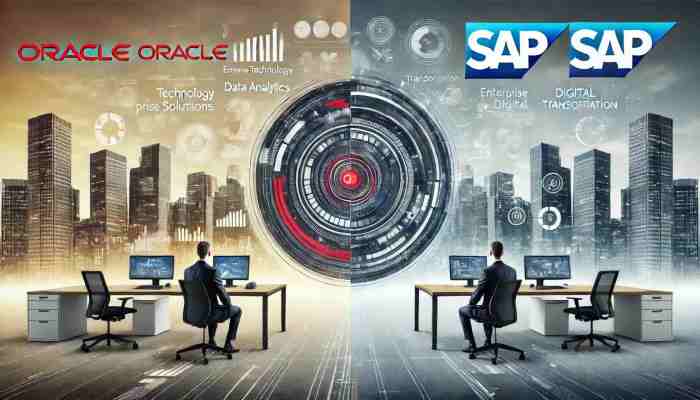
Implementing Oracle and SAP software involves a series of steps to ensure a successful integration within an organization.
Oracle:
When implementing Oracle software, the general steps typically involve:
- Planning and Preparation: Define project scope, objectives, and resources needed.
- Installation and Configuration: Set up the Oracle software according to the organization's requirements.
- Data Migration: Transfer existing data into the Oracle system without loss or corruption.
- Testing: Conduct thorough testing to ensure the software functions correctly.
- Training: Train end-users on how to effectively use the Oracle software.
- Go-Live and Support: Transition to the new system and provide ongoing support for users.
SAP:
For SAP solutions, the typical implementation process includes:
- Project Preparation: Define project goals, timeline, and resources.
- Business Blueprint: Create a detailed plan of how SAP will meet business requirements.
- Realization: Configure the SAP software based on the blueprint and develop any necessary customizations.
- Final Preparation: Conduct system testing, data migration, and end-user training.
- Go-Live and Support: Launch the SAP system and provide ongoing support for users.
Challenges Faced:
- Resistance to Change: Employees may resist adopting new software and processes.
- Data Migration Issues: Ensuring seamless transfer of data from old systems to the new software.
- Customization Complexity: Customizing the software to meet unique business needs can be challenging.
- Budget and Time Constraints: Limited resources may impact the implementation timeline and budget.
Integration with Other Systems
Integrating Oracle systems with third-party applications and ensuring compatibility of SAP software with other enterprise systems are crucial aspects of overall system effectiveness.
Oracle Integration with Third-Party Applications
Oracle provides robust integration capabilities that allow for seamless connectivity with various third-party applications. This integration is facilitated through Oracle Fusion Middleware, which acts as a bridge between Oracle systems and external applications. By utilizing technologies like APIs, web services, and connectors, organizations can easily integrate Oracle systems with a wide range of third-party software.
- Oracle integration projects often involve connecting Oracle ERP systems with CRM software such as Salesforce or Microsoft Dynamics.
- Integration with popular productivity tools like Microsoft Office 365 or Google Workspace is also common to streamline business processes.
- Additionally, Oracle systems can be integrated with e-commerce platforms like Shopify or Magento for smoother online sales operations.
SAP Compatibility with Other Enterprise Systems
SAP software is designed to be highly compatible with various enterprise systems, allowing for seamless integration with different platforms and applications. This compatibility is achieved through SAP NetWeaver, an integration platform that enables connectivity between SAP solutions and external systems.
- SAP integration projects often involve linking SAP ERP systems with supply chain management software such as IBM Sterling or Oracle SCM Cloud.
- Integration with business intelligence tools like Tableau or Power BI is common to enhance data analysis capabilities within SAP environments.
- Moreover, SAP systems can be integrated with HR management software like Workday or ADP for efficient workforce management.
Successful Integration Projects with Oracle and SAP
There have been several successful integration projects showcasing the effectiveness of Oracle and SAP systems when connected with third-party applications:
- Oracle Integration:A global manufacturing company integrated its Oracle ERP system with Salesforce CRM to improve customer relationship management and streamline order processing.
- SAP Integration:A multinational retail corporation successfully integrated its SAP ERP system with IBM Sterling supply chain management software to optimize inventory management and enhance order fulfillment processes.
Industry Applications of Oracle and SAP
Oracle and SAP are widely used in various industries due to their robust features and capabilities. Let's explore the specific sectors where these solutions are commonly applied.
Oracle Industry Applications
Oracle products are prevalent in industries such as:
- Finance: Oracle offers financial management solutions that help organizations streamline their accounting processes and manage financial data efficiently.
- Retail: Many retail companies use Oracle's retail solutions for inventory management, sales tracking, and customer relationship management.
- Manufacturing: Oracle's manufacturing applications help companies optimize production processes, manage supply chains, and improve overall operational efficiency.
SAP Industry Applications
SAP solutions are heavily relied upon in sectors like:
- Healthcare: SAP provides healthcare organizations with tools for patient management, electronic health records, and resource planning to enhance patient care and operational efficiency.
- Automotive: Many automotive companies use SAP's solutions for supply chain management, production planning, and sales and distribution to streamline their operations.
- Utilities: SAP offers utilities companies solutions for managing energy production, distribution, and customer service to ensure smooth operations and customer satisfaction.
The popularity of Oracle and SAP in specific industries can be attributed to their industry-specific functionalities, scalability, and integration capabilities.
Cost Analysis
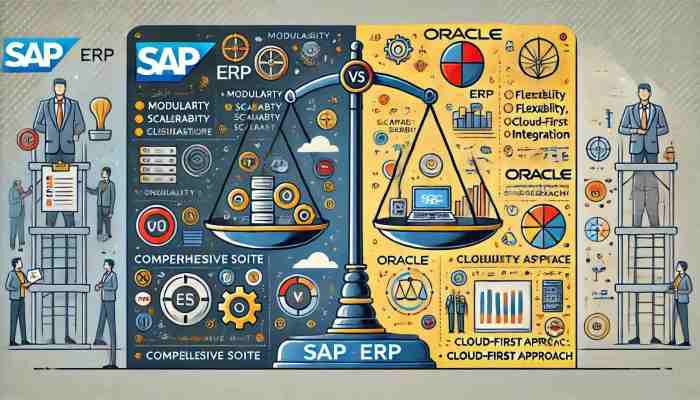
When considering the cost implications of implementing Oracle or SAP software, it is essential to break down the key factors that contribute to the overall expenses. Let's delve into the pricing models and cost structures associated with both Oracle and SAP to make an informed comparison.
Cost Factors of Oracle Software
- License Costs: Oracle typically charges for software licenses based on the number of users or processors, with additional fees for support and maintenance.
- Implementation Expenses: Costs related to customization, integration, training, and consulting services can add up significantly during the implementation phase.
- Hardware and Infrastructure: Organizations may need to invest in hardware upgrades or additional infrastructure to support Oracle software requirements.
Pricing Models of SAP Products
- Subscription Model: SAP offers subscription-based pricing for some of its products, allowing organizations to pay a recurring fee for software usage.
- Perpetual License: Some SAP products come with a one-time license fee, along with annual maintenance costs for updates and support.
- Additional Modules: Organizations may incur extra costs for add-on modules or functionalities that are not included in the base price.
Comparing Overall Cost Implications
- Initial Investment: Oracle software may require a higher upfront investment due to licensing and implementation costs, while SAP's pricing models may offer more flexibility.
- Long-term Costs: Organizations should consider the total cost of ownership over the software's lifecycle, including maintenance, upgrades, and scalability.
- Value for Money: Assessing the features, scalability, support, and customization options of Oracle and SAP can help determine the best value proposition for the organization's specific needs.
Concluding Remarks
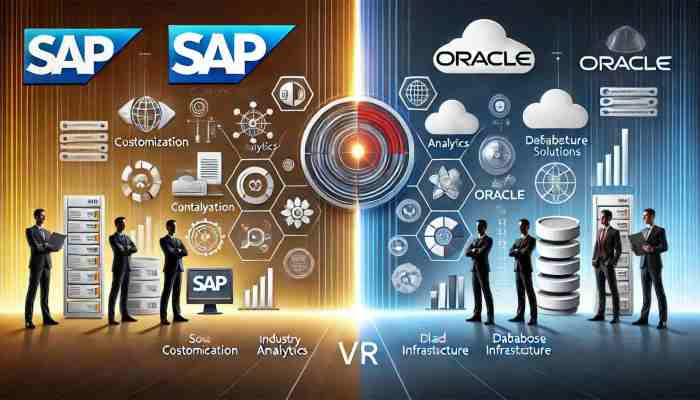
In conclusion, Oracle and SAP stand at the forefront of technological advancements, each offering unique solutions to cater to diverse business needs. As we reflect on their industry applications, integration capabilities, and cost implications, it becomes evident that both companies play indispensable roles in shaping the digital landscape.
FAQ Corner
How do Oracle and SAP differ in terms of market presence?
Oracle has a strong presence in database software, while SAP focuses on enterprise resource planning (ERP) solutions.
What are the common challenges faced during the implementation of Oracle and SAP systems?
Common challenges include data migration issues, user training requirements, and customization complexities.
Can Oracle systems easily integrate with third-party applications?
Yes, Oracle systems offer robust integration capabilities through APIs and middleware solutions.
Which industries heavily rely on SAP solutions?
Industries such as manufacturing, retail, and finance heavily rely on SAP ERP solutions for their operations.
How do the pricing models of Oracle and SAP differ?
Oracle typically follows a licensing model, while SAP offers subscription-based pricing for its products.

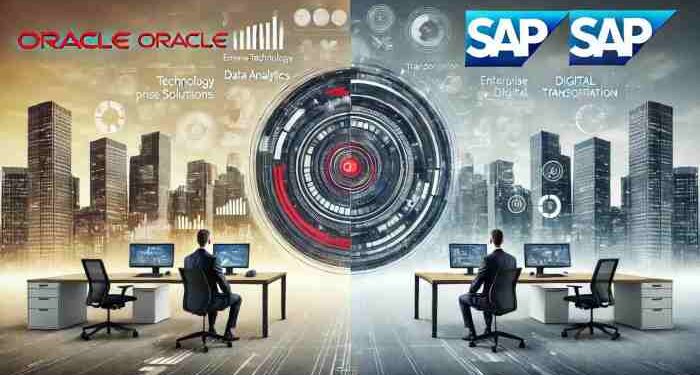






![Best Construction ERP Software [2024 Edition]](https://health.bandungnews.id/wp-content/uploads/2025/10/Top-10-Best-Construction-ERP-Software-to-Use-in-2024-1-120x86.jpg)


